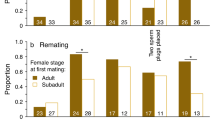Summary
The mating system of the red-necked phalarope Phalaropus lobatus is usually classed as polyandrous, but studies show that the majority of females are monogamous. Polyandry appears to be constrained because later arriving males do not usually nest with females that have already laid a clutch that season (C1-females), despite the sexual receptiveness of these females. Rather they nest with females that have not previously laid a clutch that season (C0-females). Five potential explanations of this constraint on polyandry were tested. Two hypotheses, invoking female-female competition, were not supported as female agonistic success appeared to be unrelated to priority of access to males, and there was no apparent difference between C0- and C1-females in their ability to find unpaired males. Two hypotheses suggest that C0-females are preferred by males either because they can initiate a clutch more rapidly or because they lay larger eggs. Neither hypothesis was supported by the available data. The data upheld a third male choice hypothesis that C1-females are discriminated against because they have copulated previously with another male and this may compromise paternity. Secondary males copulated and attempted to copulate more often when paired with C1-females, suggesting that sperm competition was greater and confidence of paternity was lower. Corroborative evidence of active male choice showed that males were more aggressive towards associating C1-females than towards C0-females, although how males discriminated between the two classes of females was not determined.
Similar content being viewed by others
References
Bernstein IS (1981) Dominance: the baby and the bathwater. Behav Brain Sci 4:419–457
Birkhead T (1987) Sperm competition in birds. Trends Ecol Evol 2:268–272
Birkhead TR (1988) Behavioural aspects of sperm competition in birds. Adv Study Behav 18:35–72
Birkhead TR, Atkin L, Møller AP (1987) Copulation behaviour in birds. Behaviour 101:101–138
Birkhead TR, Pellatt J, Hunter FM (1988) Extra-pair copulations and sperm competition in the zebra finch. Nature 334:60–62
Colwell MA, Oring LW (1988) Sex ratios and intrasexual competition in a sex-role reversed shorebird, Wilson's phalarope Phalaropus tricolor. Behav Ecol Sociobiol 22:165–174
Colwell MA, Oring LW (1990) Female reproductive tactics in a sex-role reversed shorebird, Wilson's phalarope Phalaropus tricolor. Natl Geogr Res (in press)
Cramp S, Simmons KEL (eds) (1983) The birds of the western Palearctic, vol 3. Oxford University Press, Oxford
Emlen ST, Oring LW (1977) Ecology, sexual selection, and the evolution of mating systems. Science 197:215–223
Erckmann WJ (1983) The evolution of polyandry in shorebirds: an evaluation of hypotheses. In: Wasser SK (ed) Social behaviour of female vertebrates. Academic Press, New York, pp 113–168
Galbraith H (1988) Effects of egg size and composition on the size, quality and survival of Lapwing Vanellus vanellus chicks. J Zool (Lond) 214:383–398
Hildén O (1975) Breeding system of Temminck's stint Calidris temminckii. Ornis Fenn 52:117–146
Hildén O, Vuolanto S (1972) Breeding biology of the red-necked phalarope (Phalaropus lobatus) in Finland. Ornis Fenn 49:57–85
Höhn EO (1968) Some observations on the breeding of northern phalaropes at Scammon Bay, Alaska. Auk 85:316–317
Höhn EO (1969) The phalarope. Sci Am 220:104–111
Howe MA (1975) Social interactions in flocks of courting Wilson's phalaropes (Phalaropus tricolor). Condor 77:24–33
Lank DB, Oring LW, Maxson SJ (1985) Mate and nutrient limitation of egg-laying in a polyandrous shorebird. Ecology 66:1513–1524
Myers JP (1981) Cross-seasonal interactions in the evolution of sandpiper social systems. Behav Ecol Sociobiol 8:195–202
Oring LW (1982) Avian mating systems. In: Farner DS, King JR, Parkes KC (eds) Avian biology, vol 6. Academic Press, New York, pp 1–92
Paassen AG van, Veldman DH, Beintema AJ (1984) A simple device for determination of incubation stages in eggs. Wildfowl 35:173–178
Parmelee DE, Payne RB (1973) On multiple broods and the breeding strategy of arctic sanderlings. Wildflow 115:218–226
Partridge L, Halliday TR (1984) Mating patterns and mate choice. In: Krebs JR, Davies NB (eds) Behavioural ecology: an evolutionary approach, 2nd edn. Blackwell, Oxford, pp 222–250
Prater AJ, Marchant JH, Vuorinen J (1977) Guide to the identification and ageing of Holarctic waders. BTO, Tring
Raner L (1972) Förekammer polyandri hos smalnäbbad simsnäppa (Phalaropus lobatus) och svarsnäppa (Tringa erythropus)? Fauna Flora: 67:135–138
Reynolds JD (1987) Mating system and nesting biology of the red-necked phalarope Phalaropus lobatus: what constrains polyandry? Fauna Flora 129:225–242
Reynolds JD, Colwell MA, Cooke E (1986) Sexual selection and spring arrival times of red-necked and Wilson's phalaropes. Behav Ecol Sociobiol 18:303–310
Schamel D, Tracy D (1987) Polyandry, replacement clutches, and site tenacity in the red phalarope (Phalaropus fulicarius) at Barrow, Alaska. Bird-Banding 48:314–324
Tinbergen N (1935) Field observations of East Greenland birds 1. The behaviour of the red-necked phalarope (Phalaropus lobatus L.) in spring. Ardea 24:1–42
Väisänen RA (1977) Geographic variation in timing of breeding and egg size in eight European species of waders. Ann Zool Fenn 14:1–25
Warren DC, Kilpatrick L (1929) Fertilization in the domestic fowl. Poult Sci 8:237–256
Westerskov K (1950) Methods for determining the age of game bird eggs. J Wildl Manage 14:56–67
Author information
Authors and Affiliations
Rights and permissions
About this article
Cite this article
Whitfield, D.P. Male choice and sperm competition as constraints on polyandry in the red-necked phalarope Phalaropus lobatus . Behav Ecol Sociobiol 27, 247–254 (1990). https://doi.org/10.1007/BF00164896
Received:
Accepted:
Issue Date:
DOI: https://doi.org/10.1007/BF00164896




